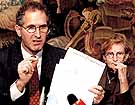
|
|
|

|

|

|

|
|
Click on an image to see a larger, more detailed picture.
|
|
|
|
|
| EPILOGUE: The Aftermath |

|
pg. 688 |

|
|
|
|
| |
 This monument to Raoul Wallenberg, who had rescued thousands of Jews, was to be erected in a Budapest, Hungary, park. But the Communist government hauled it away before it could be dedicated.
This monument to Raoul Wallenberg, who had rescued thousands of Jews, was to be erected in a Budapest, Hungary, park. But the Communist government hauled it away before it could be dedicated.
Photo: Thomas Veres / United States Holocaust Memorial Museum Photo Archive
|
|
Loss and Restitution Scholars know that keeping up with the Holocaust's history requires keeping an eye on late-breaking news. The survivors' legacy provides startling examples. In 1990 no one could have predicted that Steven Spielberg would launch the Shoah Foundation. In 1995, 50 years after the Holocaust ended, few expected that the 20th century would end with major, highly publicized international attempts to recover the huge amounts of money and property that had been expropriated from Holocaust victims. Yet no repercussions of the Holocaust have received more turn-of-the-century headlines than the complex issues surrounding the question of whether anything approximating just restitution for stolen property and slave labor can be accomplished before the survivors are gone. Along with the payments for slave labor that legal proceedings may award, the immense amounts and values of the property involved--bank accounts, stock holdings, insurance policies, stolen land, houses, buildings, businesses, jewelry, and artworks, to mention just some examples--bear witness all over again about the vastness of Nazi Germany's "Final Solution" and the economic greed that helped to motivate it.
|
 U.S. lawyer Edward Fagan and his client, Estelle Sapir, plaintiff in a class-action suit against European banks, discuss the Nazi gold case with reporters. "It's not about money," said Sapir, "it's about justice."
U.S. lawyer Edward Fagan and his client, Estelle Sapir, plaintiff in a class-action suit against European banks, discuss the Nazi gold case with reporters. "It's not about money," said Sapir, "it's about justice."
Photo: Reuters/Leonard Foeger/Archive Photos
|
|
To explore a few facets of this complex repercussion of the Holocaust, consider a Jewish woman named Estelle Sapir, who died of cardiac arrest in New York City on April 13, 1999, at the age of 72. This Holocaust survivor was born in Warsaw, Poland, where her father, Josef, was a wealthy investment banker. In 1938, while Nazi Germany prepared for war, Josef Sapir began to deposit his assets in Credit Suisse, a Swiss bank where he believed they would be safe. His planning seemed to be especially prudent--it included making deposits in more than one Swiss bank--when he and his family fled the Nazis by going to France.
|
|

|

|

|

|
 October 23, 1996: Swiss historian Peter Hug reveals documents proving that unclaimed bank accounts of Holocaust victims were used by the Swiss government to help settle Switzerland's postwar compensation disputes with Poland and Hungary. Swiss authorities announce the formation of two panels to investigate the allegations; See February 12, 1997.
October 23, 1996: Swiss historian Peter Hug reveals documents proving that unclaimed bank accounts of Holocaust victims were used by the Swiss government to help settle Switzerland's postwar compensation disputes with Poland and Hungary. Swiss authorities announce the formation of two panels to investigate the allegations; See February 12, 1997.
|
 October 29, 1996: The government of Switzerland promises to address by December 4 allegations that it appropriated the wealth of Holocaust victims in order to compensate Swiss citizens for property seized by the Nazis in Eastern Europe.
October 29, 1996: The government of Switzerland promises to address by December 4 allegations that it appropriated the wealth of Holocaust victims in order to compensate Swiss citizens for property seized by the Nazis in Eastern Europe.
|
 October 29, 1996: Art, coins, and other items looted by Nazis from the homes of Austrian Jews are sold at a benefit auction in Vienna. It is the intent of the auction organizers to keep the items in the Jewish community. By day's end, the auction grosses $13.2 million, with proceeds going to aid Holocaust survivors and their heirs.
October 29, 1996: Art, coins, and other items looted by Nazis from the homes of Austrian Jews are sold at a benefit auction in Vienna. It is the intent of the auction organizers to keep the items in the Jewish community. By day's end, the auction grosses $13.2 million, with proceeds going to aid Holocaust survivors and their heirs.
|
|
|
|
|
| EPILOGUE: The Aftermath |

|
pg. 688 |

|
|
The Holocaust Chronicle
© 2009 Publications International, Ltd.
|
|
